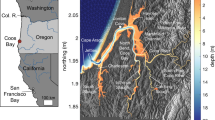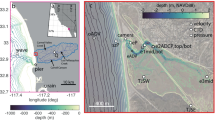Abstract
Deepening of estuarine channels is a common practice to ensure navigation. Here, we investigate whether such deepening impacts physical processes such as the strength of the estuarine exchange flow, the horizontal salinity gradient, and tidal dynamics. We analyze recent and historical hydrodynamic observations in Newark Bay, New Jersey, to assess the effect of channel deepening on tides, circulation, and salinity. The Bay’s navigational channel has undergone significant deepening, from 3 to 10 m in the nineteenth century to ~16 m today. Observations presented here include sea-level data from the nineteenth, twentieth, and twenty-first century, and moored Doppler current data and bottom salinity measurements made over the past 20 years. Results show a doubling of the estuarine exchange flow, a slight increase in salinity and in the horizontal salinity gradient, a decrease in tidal current amplitude, and a spatially variable change in the tidal range. The doubling of the exchange flow is consistent with the Hansen and Rattray scaling provided that the horizontal salinity gradient is unable to fully adjust landward because the dredging is limited to a short reach of the estuary. However, uncertainty in channel depth leaves open the possibility that the exchange flow is also augmented by an increase in the horizontal salinity gradient and/or a reduction in vertical mixing. Nevertheless, results demonstrate that a relatively small (15%) increase in depth appears to have doubled the exchange flow. We believe that this result is relevant to other systems where dredging is limited to a short reach of an estuary.











Similar content being viewed by others
Change history
20 September 2018
In the original article on page 1589, right column, second paragraph, seventh line, there is an error in the equation.
References
Amin, M. 1983. On perturbations of harmonic constants in the Thames Estuary. Geophysical Journal International 73 (3): 587–603.
Bale, A., R. Uncles, A. Villena-Lincoln, and J. Widdows. 2007. An assessment of the potential impact of dredging activity on the Tamar Estuary over the last century: bathymetric and hydrodynamic changes. Hydrobiologia 588 (1): 83–95.
Chant, R.J. 2002. Secondary flows in a region of flow curvature: relationship with tidal forcing and river discharge. Journal of Geophysical Research (C Oceans) 107 (21 September). https://doi.org/10.1023/2001JC001082.
Chant, R.J. 2006. Hydrodynamics of the Newark Bay/Kills system. New Brunswick: Rutgers University, Institute of Marine and Coastal Sciences.
Chant, R.J., D. Fugate, and E. Garvey. 2011. The shaping of an estuarine superfund site: Roles of evolving dynamics and geomorphology. Estuaries and Coasts 34: 90–105.
Chernetsky, A.S., H.M. Schuttelaars, and S.A. Talke. 2010. The effect of tidal asymmetry and temporal settling lag on sediment trapping in tidal estuaries. Ocean Dynamics 60 (5): 1219–1241.
de Jonge, V.N., H.M. Schuttelaars, J.E. van Beusekom, S.A. Talke, and H.E. de Swart. 2014. The influence of channel deepening on estuarine turbidity levels and dynamics, as exemplified by the Ems estuary. Estuarine, Coastal and Shelf Science 139: 46–59.
Devlin, A.T., D.A. Jay, S.A. Talke, and E. Zaron. 2014. Can tidal perturbations associated with sea level variations in the western Pacific Ocean be used to understand future effects of tidal evolution? Ocean Dynamics 64: 1093–120.
DiLorenzo, J.L., P. Huang, M.L. Thatcher, and T.O. Najarian. 1993. Dredging impacts on Delaware Estuary tides. Presented at Proceedings of the 3rd International Conference on Estuarine and Coastal Modeling III.
Doodson, A.T., and H.D. Warburg. 1941. Admiralty manual of tides. HM Stationery Office.
Familkhalili, R., and S. Talke. 2016. The effect of channel deepening on tides and storm surge: a case study of Wilmington, NC. Geophysical Research Letters 43 (17): 9138–9147.
Friedrichs, C.T. 2010. Barotropic tides in channelized estuaries. Contemporary Issues in Estuarine Physics: 27–61.
Hansen, D.V., and M.J. Rattray. 1965. Gravitational circulation in straits and estuaries. Journal of Marine Research 23 (2): 104–122.
Huntley, S.L., R.J. Wenning, S.H. Su, N.L. Bonnevie, and D.J. Paustenbach. 1995. Geochronology and sedimentology of the lower Passaic River, New Jersey. Estuaries 18 (2): 351–361.
Jay, D.A., and J.D. Musiak. 1994. Particle trapping in estuarine tidal flows. Journal of Geophysical Research: Oceans 99 (C10): 20445–20461.
Lane, A. 2004. Bathymetric evolution of the Mersey Estuary, UK, 1906–1997: causes and effects. Estuarine, Coastal and Shelf Science 59 (2): 249–263.
Lerczak, J.A., W.R. Geyer, and R.J. Chant. 2006. Mechanisms driving the time-dependent salt flux in a partially stratified estuary. Journal of Physical Oceanography 36 (12): 2296–2311.
Linden, P., and J. Simpson. 1988. Modulated mixing and frontogenesis in shallow seas and estuaries. Continental Shelf Research 8 (10): 1107–1127.
MacCready, P., and W.R. Geyer. 2010. Advances in estuarine physics. Annual Review of Marine Science 2 (1): 35–58.
Marmer, H.A. 1935. Tides and currents in New York harbor. US Government Printing Office.
Meyers, S.D., A.J. Linville, and M.E. Luther. 2014. Alteration of residual circulation due to large-scale infrastructure in a coastal plain estuary. Estuaries and Coasts 37 (2): 493–507.
Munk, W.H., and D.E. Cartwright. 1966. Tidal spectroscopy and prediction. Philosophical Transactions of the Royal Society of London. Series A 259: 533-81.
Officer CB. 1976. Physical oceanography of estuaries and associated coastal waters. In Physical oceanography of estuaries and associated coastal waters. John Wiley.
Pecchioli, J.A., M.S. Bruno, R.J. Chant, A.M. Pence, A.F. Blumberg, D. Fugate, B.J. Fullerton, S. Glenn, C. Haldeman, and E. Hunter et al. 2006. The New Jersey Toxics Reduction Workplan for New York—New Jersey Harbor: Study I–E—Hydrodynamic Studies in the Newark Bay Complex, 10. Trenton, NJ: New Jersey Environmental Department.
Prandle, D. 2003. Relationships between tidal dynamics and bathymetry in strongly convergent estuaries. Journal of Physical Oceanography 33 (12): 2738–2750.
Pritchard D.W. 1956. The dynamic structure of a coastal plain estuary. Journal of Marine Research 15: 33–42.
Talke, S.A., and D.A. Jay. 2017. Archival water-level measurements: Recovering historical data to help design for the future. US Army Corps of Engineers: Civil Works Technical Series, Report CWTS-02, p. 50.
Talke, S.A., H.E. de Swart, and V. De Jonge. 2009a. An idealized model and systematic process study of oxygen depletion in highly turbid estuaries. Estuaries and Coasts 32 (4): 602–620.
Talke, S.A., H.E. de Swart, and H. Schuttelaars. 2009b. Feedback between residual circulations and sediment distribution in highly turbid estuaries: an analytical model. Continental Shelf Research 29 (1): 119–135.
Talke, S.A., P. Orton, and D.A. Jay. 2014. Increasing storm tides in New York Harbor, 1844–2013. Geophysical Research Letters 41 (9): 3149–3155.
US Army Corp of Engineers (USACE). 1915. Index to the reports of the Chief of Engineers, U.S.Army, 1866-1912, Volume 1. Washington D.C.:Government Printing Office.
Wenning, R., N. Bonnevie, and S. Huntley. 1994. Accumulation of metals, polychlorinated biphenyls, and polycyclic aromatic hydrocarbons in sediments from the lower Passaic River, New Jersey. Archives of Environmental Contamination and Toxicology 27: 64–81.
Winterwerp, J.C. 2011. Fine sediment transport by tidal asymmetry in the high-concentrated Ems River: indications for a regime shift in response to channel deepening. Ocean Dynamics 61 (2-3): 203–215.
Yuan, R., and J. Zhu. 2015. The effects of dredging on tidal range and saltwater intrusion in the Pearl River Estuary. Journal of Coastal Research 31: 1357–1362.
Zhang, E., H.H.G. Savenije, H. Wu, Y. Kong, and J. Zhu. 2011. Analytical solution for salt intrusion in the Yangtze Estuary, China. Estuarine, Coastal and Shelf Science 91 (4): 492–501.
Zhu, J., R.H. Weisberg, L. Zheng, and S. Han. 2015. Influences of channel deepening and widening on the tidal and nontidal circulations of Tampa Bay. Estuaries and Coasts 38 (1): 132–150.
Acknowledgements
RJC acknowledges support from the Hudson River Foundation (HRF008/07A) and from a National Science Foundation Coastal SEES grant (1325258). CKS acknowledges support from the Hudson River Foundation (HRF008/07A) and the National Science Foundation (OCE-1325102). Stefan Talke acknowledges the U.S. Army Corps of Engineers (Award W1927N-14-2-0015) and the US National Science Foundation (Career Award 1455350). We thank Chip Haldeman and Elias Hunter for their efforts in the field, and Capt. Ken Roma for his efforts behind the helm. The authors gratefully thank two anonymous reviewers whose thoughtful comment and constructive criticisms of earlier drafts greatly improved this paper.
Author information
Authors and Affiliations
Corresponding author
Additional information
Communicated by David K. Ralston
Rights and permissions
About this article
Cite this article
Chant, R.J., Sommerfield, C.K. & Talke, S.A. Impact of Channel Deepening on Tidal and Gravitational Circulation in a Highly Engineered Estuarine Basin. Estuaries and Coasts 41, 1587–1600 (2018). https://doi.org/10.1007/s12237-018-0379-6
Received:
Revised:
Accepted:
Published:
Issue Date:
DOI: https://doi.org/10.1007/s12237-018-0379-6




